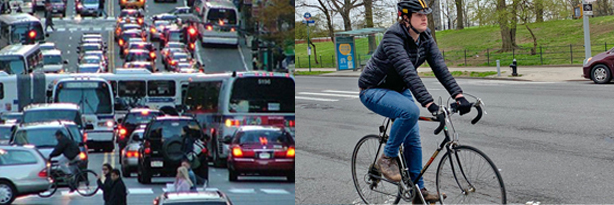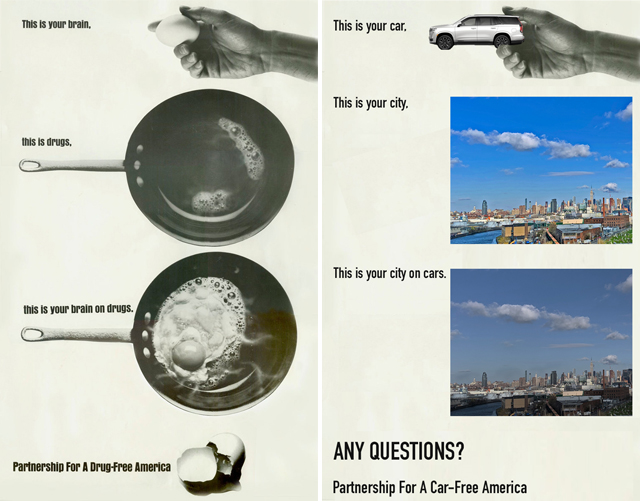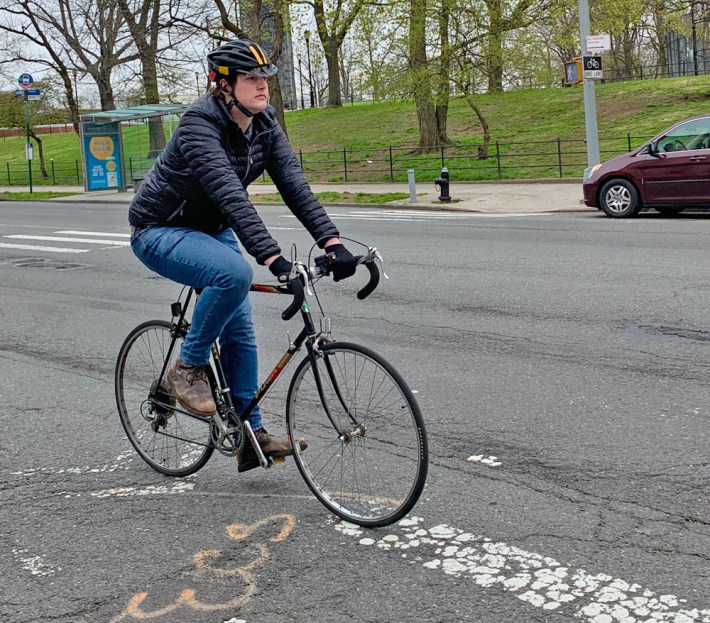Don’t Blame NY Times Reporter For Buying a Car — Blame Decades of Bad Public Policy
2:37 PM EDT on April 20, 2020

The choice is yours, Mayor de Blasio.
Editor's note: After initial publication of this story, Editor Gersh Kuntzman was persuaded into seeing that readers were taking the story as an attack on a beloved and talented New York Times reporter. Since Kuntzman did not intend the story that way, we are allowing him to post a substantially rewritten version, recast to highlight the issues that he was trying to highlight. The headline has also been altered.
After this is all over, will we be a city of Emmas or a city of Hannahs?
This is the question that Mayor de Blasio will have to figure out — and soon — lest this congested, overcrowded sclerotic city not merely go back to "normal" when this crisis is over, but get worse as people rush into the muscular arms of Detroit because our elected leaders have failed to improve conditions for cyclists, pedestrians and transit users.
Here's one scenario, laid out on Monday morning by New York Times reporter Emma Fitzsimmons:
As Fitzsimmons said, it will be interesting to see how people get around. Spoiler alert: if we don't get this right, it will also be catastrophic for our city.
Fitzsimmons is not the issue here. She's the mom of two kids and has to make whatever decision she thinks is best for her and her family. And her tweet makes a good point about the public's likely "uncertainty" about transit.
The issue is the mayor and other elected officials whose decisions today — and those made over the 10 decades of the Automobile Age — have made cars the easy choice for so many American families (even those in New York City). If a lot of people make the same choice Fitzsimmons is making, policy makers will be far more likely to leave poorer transit users behind, as they almost always do. (Indeed, the city DOT's own Vision Zero policy director Julia Kite-Laidlaw later tweeted solidarity with people who are afraid to get on the subway now — which suggests that even our public officials will abandon the subway and bus system in its greatest hour off need; failure by our leaders to fix the problem will have massive negative repercussions.)
I feel you. We’re considering the same thing. Two months ago I would have never said this, but the world has turned upside down and I will soon have responsibility for the lives of two tiny humans with undeveloped immune systems. I can’t bring them on the subway unvaccinated. https://t.co/pa6CnFVKji
— Julia Kite-Laidlaw (@juliakite) April 20, 2020
We're all victims here. Decades of subsidizing, normalizing and rationalizing car ownership as an American birthright preceded Fitzsimmons's car purchase, which she later told Streetsblog she aired publicly "because I think it’s a conversation we should be having."
"If someone like me who loves transit is considering it, then other New Yorkers probably are, too," she said. "I understand that we can’t have eight million cars in this city. This is one issue that city planners and advocates will have to address in the coming months."
And the most important "planner" in that debate will be Mayor de Blasio. Because just as Fitzsimmons has made her choice, so has Hannah Kadyrov, a newbie cyclist who began riding when the pandemic struck. Like Fitzsimmons, she doesn't want to rely on transit when this is over. But her choice to ride rather than drive suggests that a different future is possible — one where our streets are not choked by cars, where our air is not polluted by exhaust, where more than 150 cyclists and pedestrians are killed every year by drivers.
"I’m so happy to be a part of trying to make a change!" Kadyrov told Streetsblog about her decision to start using Citi Bike to get around during the pandemic.

But here's the problem: Anyone in the country can buy a car, drive it to New York and park it on a city street with no involvement of city government (except for the fact that car owners are far more subsidized than they believe). But Kadyrov's decision to continue riding after the crisis is over will require the active help of government to improve conditions for commuters like her. Hell, it takes months of community board meetings to get a single parking space removed for bike parking — yet not a single community board meeting to show up and park your Cadillac Escalade anywhere you want.
"I will not feel safe continuing once the streets return to normal," Kadyrov told Streetsblog. "Even riding in protected bike lanes, even being vigilant, doesn’t feel like enough. I am terrified of the responsibility of my life being in the hands of a driver."
Kadyrov will demand more from the mayor after the crisis is over, but will constantly be pushed back by the demands of car owners (indeed, car-loving Queens Assembly Member David Weprin told the Times earlier this month that New York will need cars more after this crisis is over). Kadyrov will want more safety for cyclists and pedestrians, which will also have the benefit of reducing traffic so that public transit can work better. She'll want the city to install a bike corral in place of a parking space (which can take more than a year of passionate advocacy even as car owners can buy whatever model they want and put it on the street for free — no community board meetings required!)
"Biking has immense benefits to New York City. It is cost effective, it is environmentally friendly, it is safer than driving!" she said. "The mayor could do things to make the city safer and reduce crashes. People could feel safer riding to get to essential places like their place of work, schools, and back to their home."
Kadyrov is certainly not the first newbie cyclist to notice the Jekyl and Hyde experience of riding in New York: the joy of freedom, but also the terror of car-dominated roadways.
"I will definitely continue to ride when things return to normal, but the idea makes me nervous," added Sam Goodson. "I go to school in Midtown and the idea of biking down there scares me."

He wants the mayor and governor to widen the Hudson River Greenway — already the nation's most popular bike lane — by taking away a lane of car traffic from the West Side Highway. (Fitzsimmons and her fellow drivers would likely object to such a move.) If not that, Goodson at least wants real bike lanes that protect cyclists — and encourage more riding.
"There are so many 'bike lanes' that are just a faded painting of a biker and nothing more, they feel practically useless," he said. "Even in places where there can't be a physical separation (which would be ideal) there should be a clearer demarcation of the lane. And more Citi Bikes where working people live! They would get a tremendous amount of use."
As drivers and new cyclists offer competing visions of the post-COVID city, Mayor de Blasio has punted. In a press conference last week, the mayor admitted that he's focused on the immediate crisis right now, and made a vague promise to work on policies that will get people "out of our cars to the maximum extent possible."
"So, yes, you will see those plans for the future of the city," he said, offering no timeline.
Paris is looking at a gradual post pandemic recovery...based on bikes.
— Bike New York (@bikenewyork) April 20, 2020
The national govt has asked Paris regional authorities for travel plans “where the bicycle would be the main means of transport allowing social distancing” https://t.co/mLgyybSyDj
Those are the very decisions that many cities are making right now. Paris's emphasis on cycling has led to massive decreases in pollution that will likely continue even after the crisis, thanks to planning by Mayor Anne Hidalgo (whose city is also dealing with an expected anxiety about public transportation). Bogota, Colombia, keeps creating scores of miles of protected bike lanes, many of which will remain in place.
New York? The mayor closed two short, long-decried gaps in the bike network — along Smith Street in Downtown Brooklyn and Second Avenue near the Queens-Midtown Tunnel — but he's done nothing else to boost cycling. In fact, he cut $10 million in Vision Zero funding for the remainder of this fiscal year and going into the next July-to-June period.
So will all the newbie cyclists stay on their bikes — or will we have a city of Emma Fitzsimmonses buying cars to feel safe?
Certainly, there will be lingering concerns about the subway — but one cyclist said that her transit anxiety motivated her to continue riding, rather than push her to buying a car.
"I want to keep biking," said the rider, who requested anonymity because she had once been harassed by the NYPD. "Streets are not safe enough. All the improvements have ultimately been half-measures, like the bike lane on Fourth Avenue, which ends at a ridiculous place and leaves cyclists with no way to get around safely. The solutions never address entire routes. Cycling relieves pressure on transit, and cars don't, so the mayor must invest in safety for cyclists."
The choice is up to the mayor.
Gersh Kuntzman is editor of Streetsblog. He writes the occasional Cycle of Rage column, which are archived here.
Gersh Kuntzman is editor in chief of Streetsblog NYC and Streetsblog USA. He also writes the Cycle of Rage column, which is archived here.
Stay in touch
Sign up for our free newsletter
More from Streetsblog New York City
OPINION: Congestion Pricing Will Help My Family Get Around As We Navigate Cancer Treatment
My partner was recently diagnosed with cancer. Congestion pricing will make getting her to treatment faster and easier.
EXCLUSIVE: OMNY Debuts on Fair Fares After Delays
The long-awaited Fair Fares expansion will launch as a three-month pilot for a few dozen riders.
Good Luck Docking Your Citi Bike In Lower Manhattan
Many frustrated commuters to Lower Manhattan opted to simply abandon their Citi Bikes undocked due to the lack of open spots in the area.




